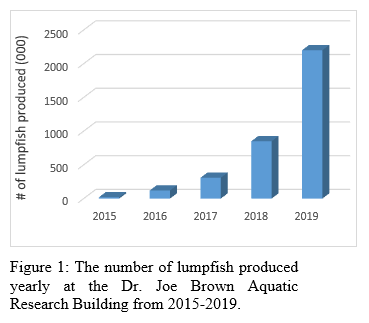CLEANER FISH RESEARCH AND PRODUCTION IN SUPPORT OF THE ATLANTIC CANADIAN SALMON AQUACULTURE INDUSTRY
In 2018, the Newfoundland Aquaculture Industry Association (NAIA) through industry consultations identified Integrated Pest Management Strategies for Sea Lice Control as the number one industry priority for Atlantic Canada’s finfish aquaculture sector. Potential losses in market value and resistance concerns related to prolonged reliance on any single therapeutant are key drivers that have prompted interest in the utilization of local cleaner fish species such as lumpfish (Cyclopterus lumpus) and cunner (Tautogolabrus adspersus). A multifaceted research team at the Department of Ocean Sciences at Memorial University is conducting research on broodstock domestication and vaccine development as well as standardizing production protocols dedicated to developing this technology for industry use to assist in mitigating and controlling sea lice on Atlantic salmon.
Cleaner fish are fish that provide a service to other species by removing ectoparasites. The feeding behaviour of the cleaner fish is harnessed to create a natural defense for the farm. The success of this strategy depends upon the availability of high quality cleaner fish in sufficient numbers. Salmon farms could possibly require upwards of 10% or more of the salmon population per cage site. Culturing cleaner fish enables a continuous supply of high quality juveniles as demand requires. Cultured cleaner fish also have the added advantage of health screening and vaccination prior to deployment to reduce risk associated with disease transfer.
As the use of cleaner fish continues to produce favourable results globally the demand for these fish increases. Powell et al. (2013) estimates that up to 50 million lumpfish are required globally. The demand for these fish has increased substantially in Atlantic Canada over the past few years (Figure 1) and protocols have been developed and modified in an attempt to meet the demand.
This talk will highlight some of the protocols and technology developed over the past few years in an attempt to meet the demand for cleaner fish in Atlantic Canada.

